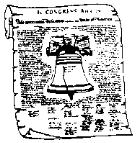

THE CONSTITUTION
Preface
 The Constitutional Convention met in the same city, the same building, and the same room from which had issued the great Declaration of Independence eleven years before. It was composed of the best brains of the land, though a few of the leading characters were conspicuously absent. John Adams and Thomas Jefferson were serving their country in Europe; Patrick Henry had been elected, but he refused to serve, so wedded was he to state rights; and we look in vain for Richard Henry Lee, for Samuel Adams, and for John Hancock, all of whom feared a stronger government, lest the sovereignty of the states and the liberty of the people be endangered.
The Constitutional Convention met in the same city, the same building, and the same room from which had issued the great Declaration of Independence eleven years before. It was composed of the best brains of the land, though a few of the leading characters were conspicuously absent. John Adams and Thomas Jefferson were serving their country in Europe; Patrick Henry had been elected, but he refused to serve, so wedded was he to state rights; and we look in vain for Richard Henry Lee, for Samuel Adams, and for John Hancock, all of whom feared a stronger government, lest the sovereignty of the states and the liberty of the people be endangered.
THE MEN THAT MADE IT
An abler body of statesmen has not assembled in modern times than that which made our Constitution in 1787, nor has any assembly met with truer motives, or produced a grander result. The whole number of delegates was fifty-five,1 and there was scarcely a man among them who had not been distinguished in the state or in the field, who had not been a governor, a member of Congress, or a commander in the army. A few had served in the Stamp Act Congress in 1765, others had set their names to the immortal Declaration in 1776, and one had framed the plan of union at Albany in 1754. Could these men have looked into the future, they would have seen two of their own number become Presidents of the United States, one a Vice President, and many others foreign ministers, members of the Supreme Court, Cabinet officials, and United States senators. These were the men who founded the Republic and started it upon its marvelous course of prosperity.
First among the framers of our Constitution stands Washington, the soldier-statesman, and next to him we must place Franklin, the philosopher and diplomat, and the oldest member of the convention. Among the most conspicuous members was John Dickinson, who was remembered for having honestly opposed the Declaration in 1776, but whose sincere patriotism could never be questioned. The most learned lawyer in the convention was James Wilson of Pennsylvania, afterward justice of the Supreme Court. For profound knowledge of constitutional law few surpassed the youthful Madison of Virginia, who came to be called the "Father of the Constitution"--not that he framed it, for it was the work of many, but because he had perhaps more to do in making it what it is than any other man. Scarcely below Madison stood the still more youthful Hamilton of New York, destined to a brief, brilliant political career, to be ended in its noonday at the hands of the duelist. In this convention we find Robert Morris, the financier of the Revolution, and Gouverneur Morris, the author of our decimal system of money. We find here Edmund Randolph, the popular governor of Virginia, who, as a patriot youth with a Tory father, had run away from his home, joined the army, and served through the war, and who, returning home, had found himself one of the most popular men in the state. He rose to the governorship, and afterward became a member of the first Cabinet in the new government. Here also were John Rutledge, the brilliant orator of South Carolina; Charles C. Pinckney, afterward a member of the famous mission to France and twice candidate of his party for the presidency of the United States; Roger Sherman, the shoemaker statesman from Connecticut; Rufus King, who was yet to spend many years in the forefront of political life; Elbridge Gerry, who name furnished us with the political term, "gerrymander," who spent many later years in public life, and who held at his death the second official position in the United States. These were the leaders of the notable assemblage that gathered at Philadelphia for the purpose of forming amore perfect union, of laying the foundations of a nation.
Footnotes
1A few others had been elected who did not attend.Return
The Constitution, Created May 7, 2000, by Kathy Leigh Copyright 2003
This website is maintained by Nathan Zipfel